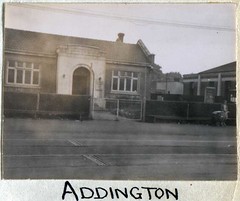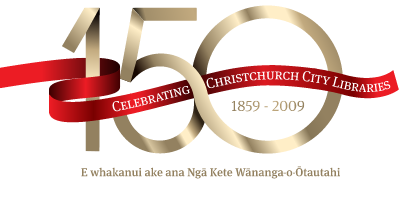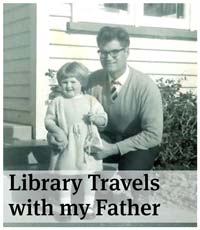Addington Library, 1918-1971
 Enthusiasm for the establishment of suburban libraries in Christchurch first flourished in the 1870s, largely because the Provincial Council made available a grant of 5000 pounds "for aiding … new and assisting existing Public Libraries, Book Clubs and Institutes in country districts"1. At this time, public meetings were held in Sydenham, Woolston, Waltham, New Brighton, Papanui, and Addington, and several libraries got underway. Addington was granted 200 pounds by the Provincial Council for a library, but at this time there was insufficient popular support for the proposal and the idea was abandoned.
Enthusiasm for the establishment of suburban libraries in Christchurch first flourished in the 1870s, largely because the Provincial Council made available a grant of 5000 pounds "for aiding … new and assisting existing Public Libraries, Book Clubs and Institutes in country districts"1. At this time, public meetings were held in Sydenham, Woolston, Waltham, New Brighton, Papanui, and Addington, and several libraries got underway. Addington was granted 200 pounds by the Provincial Council for a library, but at this time there was insufficient popular support for the proposal and the idea was abandoned.
Beginnings on Lincoln Road
It was not until 1914 that another attempt was made to establish a library in the district, but the outbreak of war prevented any action for 4 years. In April 1918, however, local residents were ready to try again. With the support of local MP and city councillor, Henry George Ell (1862-1934), and under the leadership of Edward Parlane (1874-1959), who would serve as the library's president until 1930 (when he was elected to the city council), money left over from building the band rotunda was used to purchase a site on Lincoln Road, near the Reformatory and the police station. The Council agreed to erect a suitable building, with 2 fireplaces and electric lighting, and also made a grant for the purchase of books. Donations were received from a number of local firms, and later, approaches were also made to other borough councils, including Spreydon and Riccarton. By September, 770 books had been bought at an average cost of 2 shillings and 7 pence each, and subscriptions had been taken to local newspapers (other New Zealand were added the following year), and several journals, including the Ladies' Journal, Sydney Bulletin, Life, Illustrated London News, and Popular Mechanics. The library was officially opened on 11 January 1919, with around 200 subscribers enrolling that year.
Addington Library's committee received a good deal of support from members of the Linwood library committee, especially coachbuilder, Frank Albert Drayton (1869-1956), who acted as the library's first book buyer. Early in 1919, Drayton was presented with 2 Morris chairs, in gratitude for the "sterling worth" of his efforts on behalf of the new library, 13 pounds having been collected from Addington members to buy the gift. Addington adopted the same rules as Linwood Library and set its subscription at the same level (3 pounds for life membership, 5 shillings per annum or 2 shillings and sixpence per half year, which was soon increased to 3 shillings). The library was opened each weekday evening from 7-9pm, and on Saturday afternoons from 3-4pm, with two committee members (they were all men until 1923) acting as librarians at each session. In May 1922, Wednesday afternoon sessions were added, to cater for subscribers from Halswell and other outlying districts. Librarians for this session were found among "the ladies", who also accepted responsibility for purchasing children's books.
Some initial minor difficulties over the library's finances and card system were overcome with the resignation of the first secretary, Mr N. A. Sheldon, early in 1919. He was replaced by local toymaker, Thomas Henry Tilleyshort, who remained as secretary for many years. A caretaker, Mrs C. Sloane, was also appointed at a salary of 26 pounds per annum, and honorariums were paid to both the secretary (10 guineas, which was increased to 15 guineas in 1922) and treasurer (2 guineas, later 4 guineas). Parlane, who also acted as sole book buyer for adult books, declined an honorarium, saying the work was "a pleasure". He was presented with a gift instead. A number of fund raising events were held, including card parties, dances, concerts, and guessing competitions, so that new linoleum could be laid, the grounds landscaped, and extra bookshelves added. By 1926, there were 708 subscribers enrolled, 5704 books on the shelves and Parlane was able to declare at the annual meeting that "the library has been the greatest boon of anything started in the district". The same year, Addington Library joined the New Zealand Libraries' Association, and began the regular practice of sending delegates to its annual conferences.
Depression Years
Throughout the 1920s, committee members constantly petitioned the City Council for funds to extend the library. These extensions were finally opened on 30 November 1929, a fair having been held to raise money for furnishings. Inevitably, the Depression of the 1930s impacted on the library. Evening hours were shortened to save electricity, honorariums were reduced by a third and in 1932, and all magazines were cancelled until a cheaper supplier could be found. The Council also reduced library subsidies in these years, which added to the financial difficulties. In 1934, a book-buying committee was established (something which Parlane had strongly resisted until this point), with separate buyers allocated to select fiction, non-fiction, magazines, and children's books. Several schemes to increase the number of subscribers were also introduced, including the distribution of bookmarks advertising the library, exhibitions of new books, and a series of winter lectures. Later, Addington joined other community run libraries in a radio advertising campaign. In 1938, a separate section was established for New Zealand authors, in charge of Mrs Heaven. In 1940, subscribers were allowed to borrow up to 4 extra books a week at a cost of 3d per book. Cancelled books (a book culling committee was organised in 1937) were also sold for 3d each. This system, which had been used by Linwood Library since 1909, helped considerably with fund raising. Various attempts were also made to increase subscription prices, but these were not successful until 1965, when the annual subscription was raised to 10 shillings or 6 shillings for half a year.
Post War Challenges
In the post-war period, Addington Library struggled with many of the same problems which challenged other community run libraries. The theft and damage of magazines had been an issue since the late 1920s, and poor control of lending systems meant many books went missing (in June 1936, the committee noted that over 2000 books had disappeared from the library since opening, nearly a fifth of the total stock). Some efforts were made to improve the non-fiction collections at the library (in 1963, for example, a special section for sports books was opened), but as Parlane acknowledged, the subscription system meant that the library had to buy what readers wanted, not what they should read2 . For similar reasons, offers of assistance from Canterbury Public Library to establish a modern reference collection were never taken up. As the years passed and long-serving members retired or died, it became harder to find volunteers, particularly male volunteers. In 1960, Mrs J. Johnstone became treasurer, the first female officeholder on the committee, and in April, 1963, Mrs B. Watson was appointed as temporary secretary, replacing a sick Robert Wilton Flintoff, who had served the library for 39 years. Mrs Watson was elected secretary the following year, after Flintoff's death. The same year, Mrs Burgers reported having difficulty in finding help in the children's library, so opening hours were reduced from 3 to 2 afternoons a week. Saturday evening hours also ended, the 2 librarians in charge having retired, with no replacements available. It was hard to get a good attendance at meetings, and in November 1964, the quorum was reduced from 8 members to 5. The advent of television was said to be the major factor behind the reduced appeal of the library's services.
In 1969, the library celebrated its 50th anniversary, acknowledging the "hard work and determination of a group of public spirited citizens of Addington" who had founded the institution, as well as the dedication of the volunteers who had continued the work, many over a very long period of time. In its jubilee year, the library had 336 adult members, and 446 children on its books, but the library also faced changing times. Addington was no longer purely a residential district, but was becoming increasingly industrial, with many new roads replacing the houses which had once belonged to subscribers. Accordingly, when the City Librarian reported to the Council on the future of libraries in Christchurch in May 1969, Addington was named as one of the libraries which should close.
Addington's library committee's immediate reaction was that nothing was likely to change for some years. However, a meeting with the Council in July soon dispelled this hope. The committee was told the library would close within 12 months, as the money was needed to support library services in newer residential areas. Canterbury Public Library's first professional branch library was to be built in Spreydon, and this library would serve the wider Addington area. Older readers unable to travel would access library services through the Bookmobile. This was a "very real blow" but the committee did not see that there was anything they could do, since their library building belonged to the Council, which intended to sell it. The library's final annual report was thus presented "with sad hearts" in February 1970, and the building was put to tender in December the same year. It was sold to confectionary manufacturers, Dingwall and Paulger, in February 1971 for $14,250. The library closed its doors for the last time at the end of January, just before the opening of Spreydon Library. The committee members held their final meeting on 20 January, recording the "complete harmony" in which they had worked over many years and the lifelong friends they had made, "giving their time and receiving pleasure in return". In deep regret, "the meeting closed on a note of sadness".
Sources
- Addington Library. Minute books, 1918-1971. Arch. 27, Christchurch City Libraries.
- Press, February 1926; 17 September 1969, p. 12; 23 February 1971, p. 14.
- Wood, D.E. The Christchurch Metropolitan Library Service, 1852-1948. MA thesis, Christchurch, 1950.



